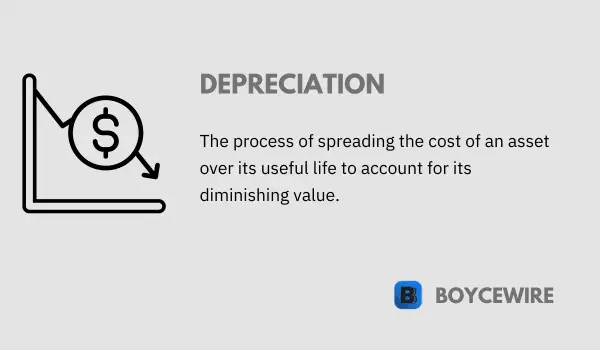Depreciation: Definition, Formula, Types & Examples

What is Depreciation?
Depreciation is a term used to account for the wear and tear on an asset over time. Whether it’s machinery for a manufacturing company, vehicles for a delivery service, or buildings for a corporation, assets tend not to last forever.
Depreciation takes into account that these assets lose value as they age, become obsolete, or get used in the company’s operations. It’s important to note that land is a notable exception in this context as it does not depreciate because it generally does not wear out or become obsolete.
It is more than just a concept; it’s a key part of sound financial management. It helps businesses maintain accurate financial records and make informed decisions. It also plays a role in tax deductions, allowing businesses to recover the cost of an asset over its lifespan.
Key Points
- Depreciation is an accounting method used to allocate the cost of an asset over its useful life.
- It reflects the gradual decrease in value or usefulness of the asset over time.
- Depreciation is important for accurately representing the cost of using assets in a business.
Understanding Depreciation
Depreciation is a fundamental concept in accounting and finance that reflects the gradual decline in the value of a long-term tangible asset due to usage, wear and tear, and obsolescence. It essentially acknowledges the inevitable economic fact that assets, over time, lose their ability to provide services or generate economic benefits.
The concept is based on two main accounting principles:
- Matching Principle: This principle dictates that expenses should be recognized in the same period as the revenue they help to generate. When a company purchases an asset, it’s likely to use it over several accounting periods to generate revenue. Therefore, the cost of the asset should be spread across those periods rather than being completely deducted in the period it was purchased.
- Conservatism Principle: This principle guides accountants to be conservative in their estimates and not to overstate the company’s financial position. By depreciating assets, companies avoid overstatement of assets on their balance sheet.
Companies record it as an expense on their income statement, reducing their net income. On the balance sheet, the accumulated depreciation is subtracted from the original cost of the asset, reflecting the decrease in the value of the asset over time.
Depreciation does not involve an actual cash transaction; it is a non-cash expense. Even though it reduces the net income, it does not reduce the cash balance of the company. The cash outflow occurred when the asset was originally purchased.
Understanding this concept is crucial for companies, investors, and stakeholders. For businesses, it helps in asset management, financial planning, and tax computation. For investors and stakeholders, depreciation gives a clearer picture of a company’s financial health and how efficiently it’s managing its assets.
Types of Depreciation
Different methods are used by businesses, each offering a unique way of calculating and recording depreciation expenses. Here are some of the most commonly used methods:
- Straight-Line: This is the simplest and most commonly used method. Under this method, the same amount is deducted from the value of the asset each year over its useful life. The formula for straight-line method is (Cost of Asset – Salvage Value) / Useful life of the asset.
- Declining Balance: This method involves depreciating the asset at a constant rate, which results in larger depreciation expenses in the early years of an asset’s life and smaller expenses in the later years. This can be useful for assets that lose value quickly early on.
- Sum-of-the-Years’ Digits: This method also results in higher depreciation in the early years of an asset’s life and lower levels later. It involves adding up the digits for each year of the asset’s useful life and then creating a fraction with the number of years remaining as the numerator and the sum as the denominator.
- Units of Production: This method ties depreciation directly to the amount of use or the number of units an asset produces, making it a good choice for manufacturing equipment or vehicles that wear out according to how much they’re used rather than how old they are.
Choosing the right method is important as it can significantly impact a company’s financial statements and tax liabilities. The choice depends on several factors, including the nature of the asset, the expected pattern of economic benefits, and management’s judgment.
Calculating Depreciation
The method of calculating depreciation varies depending on the method chosen. Here’s a brief look at how to calculate it using some of the common methods:
- Straight-Line: This method spreads the cost of the asset evenly over its useful life. The formula is:
Depreciation Expense = (Cost of Asset – Salvage Value) / Useful Life of the Asset - Declining Balance: This method applies a constant rate of depreciation to the decreasing book value of the asset each year. The formula is:
Depreciation Expense = Book Value at Beginning of Year * Depreciation Rate - Sum-of-the-Years’ Digits: This method assigns a fraction of the asset’s depreciable cost (cost – salvage value) to each accounting period. The formula is:
Depreciation Expense = (Remaining Life / Sum of the Years’ Digits) * Depreciable Cost - Units of Production: This method calculates depreciation based on actual usage or production. The formula is:
Depreciation Expense = ((Cost of Asset – Salvage Value) / Total Expected Units of Production) * Units Produced in the Period
The choice of method and the assumptions used to calculate depreciation can have a significant impact on a company’s reported profits and book value of assets, so it’s crucial to carefully consider these decisions.
Examples of Depreciation
Let’s illustrate the concept of depreciation through an example using the straight-line method and the declining balance method.
Example 1: Straight-Line
Company A purchases a piece of machinery for $10,000. The machine has a useful life of 10 years and a salvage value of $1,000. Using the straight-line method, the depreciation expense per year would be:
($10,000 – $1,000) / 10 = $900
So, Company A would record a depreciation expense of $900 each year for 10 years.
Example 2: Declining Balance
Let’s say Company B purchases a computer system for $5,000. The system has a useful life of 5 years. In the declining balance method, the salvage value is not considered in the calculation. Assume we’re using double-declining balance method, which means the straight-line rate (100% / 5 years = 20%) is doubled to 40%.
In the first year, the depreciation expense would be:
$5,000 * 40% = $2,000
For the second year, the book value of the computer system at the beginning of the year would be $5,000 – $2,000 = $3,000. So, the depreciation expense would be:
$3,000 * 40% = $1,200
The process continues for each of the remaining years, reducing the book value by the previous year’s depreciation until the value of the asset is reduced to its salvage value.
These examples give a simple illustration of how depreciation works. In reality, the process may be more complex due to factors such as improvements made to the assets, changes in useful life estimates, or asset impairments.
FAQs
Depreciation is an accounting method used to allocate the cost of an asset over its useful life to reflect its gradual decrease in value or usefulness.
Depreciation is important for accurately representing the true cost of using assets in a business. It helps match expenses with the revenue generated by those assets over their useful life.
Depreciation is calculated using various methods, such as straight-line, declining balance, and units-of-production. Each method determines how much of the asset’s cost is allocated as an expense in each accounting period.
Several factors influence the depreciation of an asset, including its initial cost, useful life, salvage value (if any), and the chosen method.
About Paul
Paul Boyce is an economics editor with over 10 years experience in the industry. Currently working as a consultant within the financial services sector, Paul is the CEO and chief editor of BoyceWire. He has written publications for FEE, the Mises Institute, and many others.

Further Reading
 Second Degree Price Discrimination: Examples & Graph - Second degree price discrimination is where a firm sells at different prices based on quantity. This may include offers such…
Second Degree Price Discrimination: Examples & Graph - Second degree price discrimination is where a firm sells at different prices based on quantity. This may include offers such…  Externalities: Definition, Positive & Negative Examples - In economics, an externality refers to a cost or benefit that is imposed onto a third party.
Externalities: Definition, Positive & Negative Examples - In economics, an externality refers to a cost or benefit that is imposed onto a third party.  Division of Labor - The division of labor refers to the segmentation of tasks, so each person focuses on a specific part of the…
Division of Labor - The division of labor refers to the segmentation of tasks, so each person focuses on a specific part of the… 
